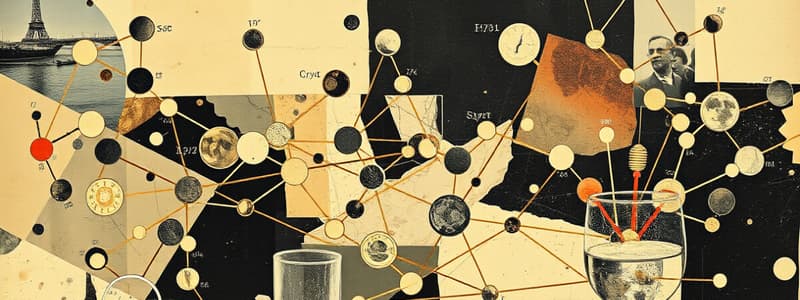Podcast
Questions and Answers
What is the primary role of hydrogen bonds in complex molecules?
What is the primary role of hydrogen bonds in complex molecules?
- To determine the shape of complex molecules (correct)
- To facilitate nutrient absorption
- To dissociate molecules in water
- To store energy within chemical bonds
Which of the following substances can dissolve in water?
Which of the following substances can dissolve in water?
- Oils
- Plastic
- Athletic tape
- Sugar (correct)
What is a characteristic of electrolytes in solution?
What is a characteristic of electrolytes in solution?
- They result from the dissociation of ions in water (correct)
- They do not conduct electric current
- They consist of only cations
- They always form nonpolar solutions
Which reaction type is described as the synthesis of two or more reactants to form a larger product?
Which reaction type is described as the synthesis of two or more reactants to form a larger product?
What happens to ions during the dissociation of ionic compounds in water?
What happens to ions during the dissociation of ionic compounds in water?
In the context of synthesis reactions, what is a dehydration reaction?
In the context of synthesis reactions, what is a dehydration reaction?
Which of the following is NOT a characteristic of nonelectrolytes?
Which of the following is NOT a characteristic of nonelectrolytes?
What defines anabolism in the body?
What defines anabolism in the body?
What is the collective term for decomposition reactions in the body?
What is the collective term for decomposition reactions in the body?
Which of the following best describes reversible reactions?
Which of the following best describes reversible reactions?
What defines a substance as inorganic in chemistry?
What defines a substance as inorganic in chemistry?
What property of water enables it to exhibit surface tension?
What property of water enables it to exhibit surface tension?
What is the role of water in hydrolysis reactions?
What is the role of water in hydrolysis reactions?
Which of the following correctly defines an acid?
Which of the following correctly defines an acid?
What occurs when a base dissociates in solution?
What occurs when a base dissociates in solution?
What is the primary function of water's adhesion property?
What is the primary function of water's adhesion property?
What pH value represents a neutral solution?
What pH value represents a neutral solution?
Which condition occurs when blood pH drops below 7.35?
Which condition occurs when blood pH drops below 7.35?
Which of the following statements about alkaline solutions is correct?
Which of the following statements about alkaline solutions is correct?
What is the normal pH range for human blood?
What is the normal pH range for human blood?
What type of organic molecule are carbohydrates primarily composed of?
What type of organic molecule are carbohydrates primarily composed of?
Which of the following best characterizes lipids?
Which of the following best characterizes lipids?
What happens to the nervous system when blood pH rises above 7.45?
What happens to the nervous system when blood pH rises above 7.45?
Which of the following substances would typically be considered acidic based on its pH?
Which of the following substances would typically be considered acidic based on its pH?
What characterizes the quaternary structure of proteins?
What characterizes the quaternary structure of proteins?
Which of the following statements about DNA is correct?
Which of the following statements about DNA is correct?
What components make up a nucleotide?
What components make up a nucleotide?
How are the two strands of a DNA molecule oriented?
How are the two strands of a DNA molecule oriented?
What determines the primary structure of a protein?
What determines the primary structure of a protein?
What characterizes trans fats?
What characterizes trans fats?
What is the primary function of phospholipids?
What is the primary function of phospholipids?
Which of the following statements about steroids is true?
Which of the following statements about steroids is true?
What type of bond forms between amino acids during protein synthesis?
What type of bond forms between amino acids during protein synthesis?
What distinguishes the 20 different amino acids?
What distinguishes the 20 different amino acids?
What does denaturation refer to in protein structure?
What does denaturation refer to in protein structure?
Which level of protein structure is defined by the overall three-dimensional shape of a polypeptide?
Which level of protein structure is defined by the overall three-dimensional shape of a polypeptide?
What stabilizes the tertiary structure of proteins?
What stabilizes the tertiary structure of proteins?
Flashcards are hidden until you start studying
Study Notes
Hydrogen Bonds
- Formed between positively charged hydrogen and negatively charged atoms (O, N, F) in other molecules.
- In water, hydrogen of one molecule bonds with oxygen of another, influencing the shape of complex molecules.
Solubility and Dissociation
- Solubility: Ability of a substance to dissolve in another; sugar and salt dissolve in water, but oils do not.
- Dissociation: In ionic compounds, cations and anions separate in water due to opposite attractions from water molecules.
Electrolytes and Nonelectrolytes
- Electrolytes: Solutions formed by dissociation of ions, capable of conducting electricity.
- Nonelectrolytes: Molecules that dissolve in water but do not dissociate, thus do not conduct electricity.
- Proper electrolyte balance is crucial for physiological processes.
Synthesis Reactions
- Two or more reactants combine to form a larger product.
- Also known as anabolism; energy is stored in chemical bonds.
- Examples include the formation of carbohydrates, proteins, lipids, and nucleic acids.
Decomposition Reactions
- Large reactants are broken down into smaller products; known as catabolism.
- Energy is released when chemical bonds break.
- Hydrolysis reactions involve water splitting to form products.
Reversible Reactions
- Reactions can proceed in both directions, either forming products or reverting to reactants.
- At equilibrium, the rate of formation of products equals the rate of formation of reactants.
Inorganic Chemistry
- Focuses on substances without carbon-hydrogen bonds; examples include water, oxygen, and calcium phosphate.
- Organic chemistry studies carbon-containing substances.
Water
- Polar molecule influencing interactions with hydrophilic (water-attracted) and hydrophobic (water-fearing) substances.
- Cohesion (water attraction to itself) creates surface tension; adhesion (water attraction to other molecules) aids plant water transport.
- Constitutes 50-60% of the body and 92% of blood.
Acids and Bases
- Acid: Proton donor that releases hydrogen ions.
- Base: Proton acceptor that binds to or accepts hydrogen ions.
The pH Scale
- Measures hydrogen ion concentration in solutions.
- Neutral is pH 7; acidic is below 7; alkaline (basic) is above 7.
Normal and Abnormal Body pH
- Normal pH for blood ranges from 7.35 to 7.45.
- Acidosis occurs below 7.35, leading to depression of the nervous system.
- Alkalosis occurs above 7.45, causing nervous system excitability.
Organic Molecules
- Carbohydrates: Composed of C, H, O; categorized into monosaccharides, disaccharides, polysaccharides; serve as energy sources.
- Lipids: Mainly C, H, O; includes trans fats which pose cardiovascular risks; critical for cell membrane structure.
Lipids: Phospholipids and Steroids
- Phospholipids: One fatty acid replaced with phosphate; crucial for cell membrane structure due to their amphipathic nature.
- Steroids: Lipids with a four-ring structure; includes cholesterol (cell membranes) and reproductive hormones (estrogen, testosterone).
Proteins and Amino Acids
- Proteins: Composed of amino acids linked by peptide bonds through dehydration synthesis.
- Amino acids consist of an amino group, a carboxyl group, a central carbon, and an R side chain distinguishing them.
Protein Structure
- Primary Structure: Sequence of amino acids.
- Secondary Structure: Hydrogen bonds form pleated sheets or helices.
- Tertiary Structure: Large-scale folding stabilized by disulfide bonds; determines protein function.
- Quaternary Structure: Association of multiple protein subunits.
Nucleic Acids: DNA and RNA
- Composed of nucleotides, including DNA and RNA, essential for genetic information.
- DNA consists of two strands with complementary bases (A-T, G-C) forming a double helix.
Structure of DNA
- Sugar-phosphate backbones running in opposite directions; genes coded by base sequences dictate protein synthesis.
Studying That Suits You
Use AI to generate personalized quizzes and flashcards to suit your learning preferences.




